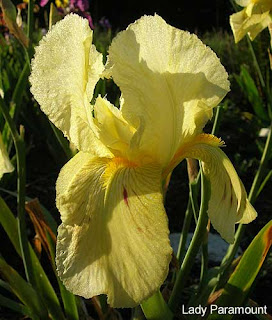By Sylvain Reuad
To name an iris after a real person (I think it is the same for other flowers) one must follow special rules. As part of the process, it is necessary to attach to the registration request a signed consent of the named person when she or he is alive. It was less formal in the 1920s and 1930s, and hybridizers of the time did not hesitate to pay homage to some notable or some friend or acquaintance, in particular as a gallantry to a lady! Just in the list of varieties registered by Ferdinand Cayeux, I noted 22 names of varieties dedicated to one particular lady. His colleagues Denis and Millet followed the same policy and several of their varieties bear the name of a lady of their time; they are either a few members of their family, or the wives or daughters of notables to whom they wish to pay homage. The only exception was Philippe Vilmorin, perhaps to stand out from competitors!
A large number of these varieties can still be found in specialized gardens and in the collections of a few individuals who are passionate about historic irises.
Starting with the selections of Jean-Nicolas Lémon, otherwise known as Lémon fils (son). One of the very first dedicated varieties is 'Julia Grisy', an indigo plicata on a bluish white background which is described as follows in the Annals of the Société Royale d'Horticulture de Paris in 1842: "Narrow foliage, medium flowers, petals exterior (1) wide, streaked with purplish blue, largely bordered with white ”.
Neither the person to whom it owes its name nor this flower has survived the wear of time. This is fortunately not the case of 'Madame Chéreau' (1844) which is one of the selections of JN Lémon still present in many gardens and considered the most important iris of his lines. The Bulletin of the General Circle of Horticulture of 1845 gives a delightful and time-bound description of it: “Your Commission noticed in the seedlings of Mr. Lemon charming gains; she examined them with scrupulous care; and, wishing to describe some of them to make them known to you, she found herself embarrassed over the choice to be made since all the varieties were remarkable; nevertheless forced to rule, it opted in favor of six of them, to which a serial number was applied.
The number one was a beautiful white background, bordered with blue streaks; the outer petals roughly the same color, but the streaks do not extend to the edge; it is thus trimmed with a beautiful white ribbon which gives this flower a cheerful appearance. She is worthy of a distinguished patronage, so we called her 'Madame Chéreau'... ” Lady Chéreau was none other than the wife of the director of the Royal Horticultural Society.
Among the many selections of JN Lémon there are several varieties with ladies' names, which are now forgotten: for example,' Duchesse de Nemours' (1848),' Madame 'Rousselon' (1842), 'Amélie Mairet' (1845 ) or another celebrity, 'Victoire Lemon' (ca 1845), also called 'Madame Lémon'.
A little later, around 1860 and until the end of the century, it was the Verdier family who took up the torch for the cultivation of irises. The custom of giving a variety the name of a lady is still respected, and among the dedications of the Verdier family there is a curiosity, 'Sister Superior Albert.' There also was (one iris that we only know the name and variety, that survived to the present day), called 'Madame Louesse' (1860).
There was also one of Ferdinand Cayeux's first varieties called 'Madame Blanche Pion' (1906); it is an amber yellow variety on a purple base, perhaps extinct. But other varieties less known are:
'Jacqueline Guillot' (1924), lavender blue:
'Charlotte Millet' (1927), purple:
'Geneviève Serouge' (1932), pale blue, infused with primrose yellow:
'Madame Ulman' (1936), lilac and purple:
'Anne-Marie Berthier' (1939), white:
'Marie-Rose Martin' (1939), yellow centered in pale lilac:
There is also a rather mysterious plant, which is known only by its offspring: 'Clémentine Croutel' (ca 1925) (2).
The colleagues of Ferdinand Cayeux did not stay behind on this subject. The Millet family, such as Armand, Alexandre then Lionel, were active in the interwar period. They were the creators of:
'Mady Carrière' (1905), two tones of light mauve:
'Yvonne Pelletier' (1916), light orchid pink marked with yellow on the shoulders;
'Simone Vaissière' (1921), lavender blue neglecta:
'Madame Cécile Bouscant' (1923), pink orchid; 'Germaine Perthuis' (1924), luscious purple:
but their greatest achievement is certainly the famous purplish blue 'Souvenir de Mme Gaudichau' (1914).
As for Fernand Denis, missing in 1935, the SNHF bulletin of 1935 said in his obituary chronicle about him: "In a long series of years, he tried to improve the irises of the gardens by using for his hybridizations the I. Ricardi of Palestine. “ He therefore introduced tetraploid irises to France. In the area that concerns us today, we owe him, among other things:
'Mademoiselle Schwartz' (1916), lavender blue:
'Madame Chobaut' (1916), pink plicata:
'Edith Cavell' (1921), white strongly marked with yellow on the shoulders:
'Andrée Autissier' (1921), sky blue.
Many other varieties could be mentioned bearing the name of ladies recorded during those years when French irises had the reputation of being among the most beautiful in the world. If the misfortunes of the Second World War interrupted their glory, they gradually reclaimed it from the 1960s. And the tradition of giving ladies' names has continued unabated, and has spread throughout the world.
(1) The sepals of the flower are thus designated.
(2) Two descendants of 'Clémentine Croutel' are advantageously known: 'Nêne' (1928) and 'Hélios'


























































